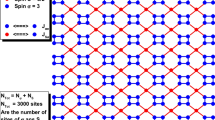Summary.
The approach of molecular potentials describing the shape of transition curves of spin crossover in the solid state developed earlier has been extended to many-body interactions characterized by the Axilrod-Teller potential. An improved procedure for the minimization of energy developed for this case is presented. Calculations for systems involving Lennard-Jones, electric dipole–dipole, and dispersive Axilrod-Teller triple interactions yield non-zero asymmetries of splittings in expanded/compressed systems alone. The excess energy is unaffected by the Axilrod-Teller potential. Triple interactions of the Axilrod-Teller type thus increase the sensitivity of a transition curve towards compression.
Another approach presented employs the deviations of molecules from positions of mechanical equilibrium set up by the known binary potential. In the approximation of small perturbations these deviations are proportional to the gradients of many-center potentials. This allows one to parametrically define non-ideality parameters as functions of gradients of triple potentials of unknown types. Employing regularization bounds an adequate parameterization of experimental transition curve of spin crossover has been achieved in terms of parameters of Lennard-Jones potential and relative deviations of molecules from the position of mechanical equilibrium.
Similar content being viewed by others
References
Jansen L (1965) ‘Many-centre forces and stability of crystals’. In: Sinanoglu O (ed.) ‘Modern Quantum Chemistry (Istanbul Lectures)’: Academic Press, New York
VI Zubov (2002) Phys St Solidi 253 151
RJ Sadus (1998) Fluid Phase Equil 150–151 63
KP Shukla (1989) Fluid Phase Equil 46 1 Occurrence Handle10.1016/0378-3812(89)80271-7 Occurrence Handle1:CAS:528:DyaL1MXltVehurw%3D
AB Koudriavtsev (1999) Chem Phys 241 109 Occurrence Handle10.1016/S0301-0104(98)00405-4 Occurrence Handle1:CAS:528:DyaK1MXlvValtQ%3D%3D
AB Koudriavtsev AF Stassen JG Haasnoot M Grunert P Weinberger W Linert (2003) Phys Chem Chem Phys 5 3666 Occurrence Handle1:CAS:528:DC%2BD3sXmsVShu74%3D
AB Koudriavtsev AF Stassen JG Haasnoot M Grunert P Weinberger W Linert (2003) Phys Chem Chem Phys 5 3676 Occurrence Handle1:CAS:528:DC%2BD3sXmsVShu7w%3D
AB Koudriavtsev W Linert (2005) Monatsh Chem 137 15
AB Koudriavtsev W Linert (2005) Monatsh Chem 137 35
HA Goodwin (1976) Coord Chem Reviews 18 293 Occurrence Handle1:CAS:528:DyaE28Xktlyksb0%3D
M Sorai J Ensling KM Hasselbach P Gütlich (1977) Chem Phys 20 197 Occurrence Handle10.1016/0301-0104(77)85023-4 Occurrence Handle1:CAS:528:DyaE2sXhs1ehsbg%3D
H Köppen EW Müller CP Köhler H Spiering E Meissner P Gütlich (1982) Chem Phys Lett 91 348 Occurrence Handle10.1016/0009-2614(82)83298-3
BM Axilrod E Teller (1943) J Chem Phys 11 299 Occurrence Handle10.1063/1.1723844 Occurrence Handle1:CAS:528:DyaH3sXjtlShsA%3D%3D
Moelwyn-Hughes EA (1970) ‘Physikalische Chemie’, Georg Thieme Verlag, Stuttgart
Hückel W (1954) ‘Theoretische Grundlagen der Organischen Chemie’ Bd. 2, Leipzig
A Bousseksou J Nasser J Linares K Boukheddaden F Varret (1992) J Phys I France 2 1381 Occurrence Handle10.1051/jp1:1992217 Occurrence Handle1:CAS:528:DyaK38Xlt1eis7o%3D
M Sorai (2001) Bull Chem Soc Jap 74 2223 Occurrence Handle1:CAS:528:DC%2BD38XjtlGjug%3D%3D
D Chernyshov M Hostettler KW Törnroos H-B Bürgi (2003) Angew Chem Int Ed 42 3825 Occurrence Handle10.1002/anie.200351834 Occurrence Handle1:CAS:528:DC%2BD3sXntV2ltr4%3D
Kudriavtsev AB, Linert W (1996) Physico-Chemical Applications of NMR. WSPC, Singapore
Author information
Authors and Affiliations
Corresponding author
Rights and permissions
About this article
Cite this article
Koudriavtsev, A., Linert, W. The Role of Binary and Many-center Molecular Interactions in Spin Crossover in the Solid State. Part III. Expressing Many-body Interactions. Monatsh. Chem. 137, 433–447 (2006). https://doi.org/10.1007/s00706-005-0454-0
Received:
Accepted:
Published:
Issue Date:
DOI: https://doi.org/10.1007/s00706-005-0454-0




